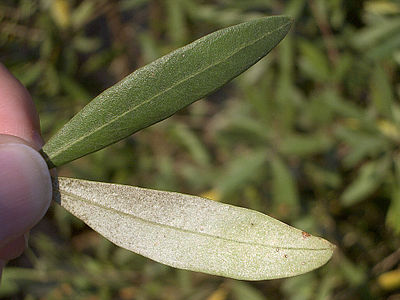
Search
Olive leaf

Olive leaf is the leaf of the olive tree (Olea europaea). Although olive oil is well known for its flavor and possible health benefits, the leaf and its extracts remain under preliminary research with unknown effects on human health.
Leaf characteristics
The silvery green leaves are oblong, measuring 4–10 centimetres (1.6–3.9 inches) long and 1–3 centimetres (0.39–1.18 inches) wide. When consumed, leaves have an astringent bitter taste.
Chemical compounds
Olive phenolics are much more concentrated in the leaves compared with olive fruit or olive oil: 1450 mg total phenolics/100 g fresh leaf vs. 110 mg/100 g fruit and 23 mg/100 ml extra virgin olive oil. Chemical compounds in unprocessed olive leaf are oleuropein and hydroxytyrosol, as well as polyphenols and flavonoids, including luteolin, rutin, caffeic acid, catechin and apigenin. Elenolic acid is a component of olive oil and olive leaf extract. It can be considered as a marker for maturation of olives. Oleuropein, together with other closely related compounds such as 10-hydroxyoleuropein, ligstroside and 10-hydroxyligstroside, are tyrosol esters of elenolic acid. The phenolic composition of olive leaf extract varies according to plant variety, harvesting season and method, leaf maturity, storage conditions and extraction method.
Culinary uses
Olive leaves are sometimes used in deluxe Chinese cuisine. Olive leaves have been used by Gina Keatley in the creation of Matche, powdered olive leaves used on desserts and in tea.
Research
Scientific evidence for the supposed health effect of using olive leaf extract to manage blood glucose levels has been deemed insufficient by the European Food Safety Authority to have any cause-and-effect relationship.
References
Text submitted to CC-BY-SA license. Source: Olive leaf by Wikipedia (Historical)
Owlapps.net - since 2012 - Les chouettes applications du hibou


